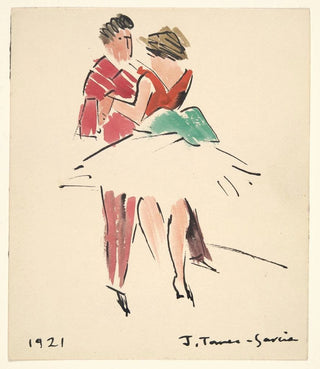Art print | Bal des Artistes Deux danseurs - Joaquín Torres-García


View from behind

Frame (optional)
In the fascinating world of art, some works transcend time and space, captivating minds and awakening emotions. "Bal des Artistes Deux danseurs" by Joaquín Torres-García is one of those creations that, through its beauty and originality, invites deep reflection on dance, life, and harmony. This painting, imbued with a vibrant atmosphere, evokes a fleeting moment where art and performance meet, revealing the magic of a suspended instant. Contemplating this piece, the viewer is transported to a universe where the grace of movements and the richness of colors intertwine, creating an immersive and unforgettable experience.
Style and uniqueness of the work
Torres-García's style is distinguished by a unique approach that blends abstraction and figuration, offering a personal vision of the world around him. In "Bal des Artistes Deux danseurs," the figures of the dancers are stylized, almost geometric, while maintaining a certain fluidity that suggests movement. The vibrant colors and dynamic shapes combine to give life to a scene that seems to dance itself. This work perfectly illustrates the ability of art to capture the very essence of performance, while inviting the viewer to question the nature of beauty and artistic expression. The composition, both balanced and bold, demonstrates technical mastery that allows the piece to assert itself with strength and delicacy.
The artist and his influence
Joaquín Torres-García, an emblematic figure of modern art, dedicated his life to exploring the limits of creativity. Born in Uruguay, he studied in Paris before returning to South America, where he played a decisive role in the development of Latin American art. His work is marked by a constant quest for harmony between European influences and local traditions. Torres-García knew how to incorporate elements of pre-Columbian culture into his creations, thus offering a new perspective on artistic identity. His influence endures today, inspiring many artists around the world to explore their own cultural heritage while opening up to

Matte finish

View from behind

Frame (optional)
In the fascinating world of art, some works transcend time and space, captivating minds and awakening emotions. "Bal des Artistes Deux danseurs" by Joaquín Torres-García is one of those creations that, through its beauty and originality, invites deep reflection on dance, life, and harmony. This painting, imbued with a vibrant atmosphere, evokes a fleeting moment where art and performance meet, revealing the magic of a suspended instant. Contemplating this piece, the viewer is transported to a universe where the grace of movements and the richness of colors intertwine, creating an immersive and unforgettable experience.
Style and uniqueness of the work
Torres-García's style is distinguished by a unique approach that blends abstraction and figuration, offering a personal vision of the world around him. In "Bal des Artistes Deux danseurs," the figures of the dancers are stylized, almost geometric, while maintaining a certain fluidity that suggests movement. The vibrant colors and dynamic shapes combine to give life to a scene that seems to dance itself. This work perfectly illustrates the ability of art to capture the very essence of performance, while inviting the viewer to question the nature of beauty and artistic expression. The composition, both balanced and bold, demonstrates technical mastery that allows the piece to assert itself with strength and delicacy.
The artist and his influence
Joaquín Torres-García, an emblematic figure of modern art, dedicated his life to exploring the limits of creativity. Born in Uruguay, he studied in Paris before returning to South America, where he played a decisive role in the development of Latin American art. His work is marked by a constant quest for harmony between European influences and local traditions. Torres-García knew how to incorporate elements of pre-Columbian culture into his creations, thus offering a new perspective on artistic identity. His influence endures today, inspiring many artists around the world to explore their own cultural heritage while opening up to






